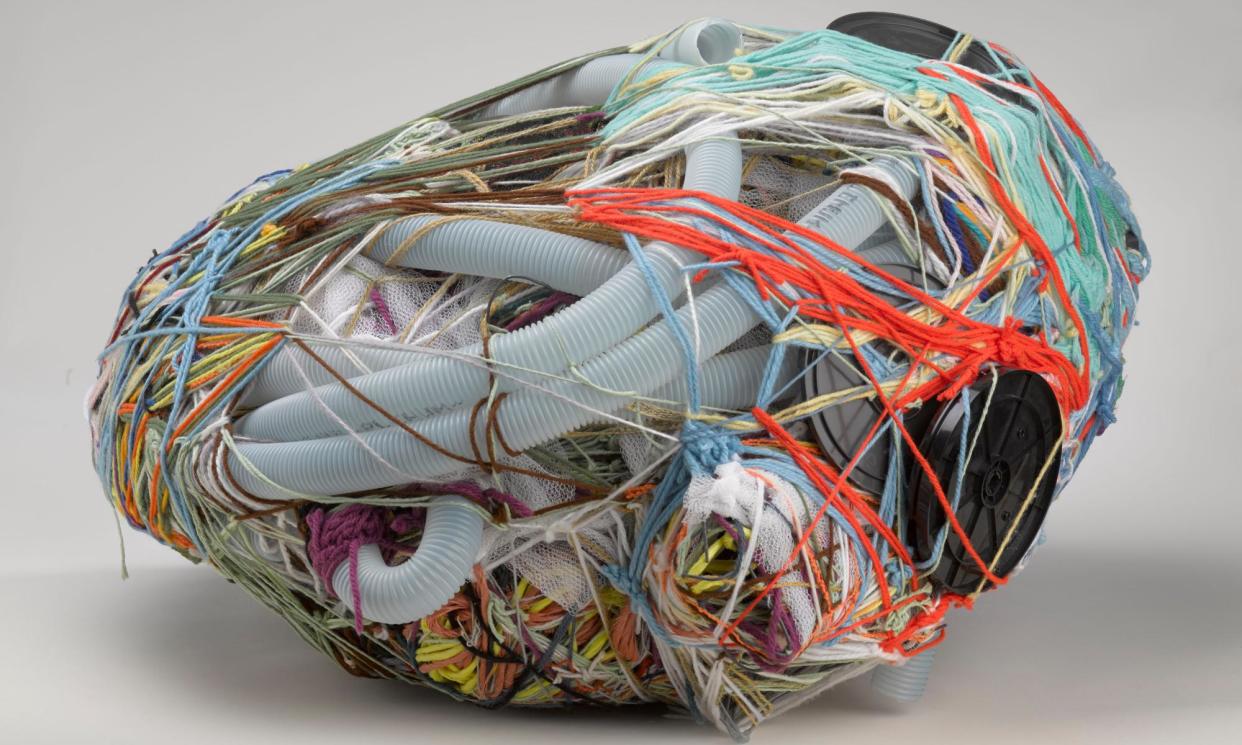How Judith Scott escaped a life in institutional isolation to become a great sculptor

Bundles of fibre wrapped around shapes as if mummifying something sacred. Bicycle wheels tied tightly to a chair with scraps of kaleidoscopically coloured cloth. Supermarket trolleys filled to the brim with ropes, tubes, tassels. Forms evoking wings, animals or body-parts that seem to be conversing with each other. This is the work of Judith Scott.
Scott was fanatical about fibre. She would work on her sculptures for months at a time, going for hours without stopping. She would smack her hands together when she knew a piece was done – and immediately get to work on the next. She wore bright pink felt hats and jumpers, and wrapped her head in vibrantly patterned cloth.
Born 81 years ago this week, Scott was 61 when she died in 2005, and spent the last 17 years of her life making art at the non-profit Creative Growth Art Center, an innovative studio in Oakland, California, for people with developmental disabilities. A twin – her sister Joyce was born without disabilities – Scott was deaf and had Down syndrome.
From the age of seven, she was placed in a series of institutions, enduring horrific conditions for more than 35 years. Sadly, she was born before the kind of legal protections that were implemented after scandals such as Willowbrook, a New York facility in which disabled children were brutalised, while the disability rights campaign, which took place in tandem with other social justice movements of the 60s and 70s, was some way off.
It wasn’t until 1985, when Joyce became her legal guardian and enrolled her at Creative Growth, that Scott turned to art. While she made nothing for her first two years at the centre, after taking part in a fibre art workshop she became obsessed by threads, spending every day until her death fastidiously wrapping and spinning fibres around objects, transforming them into her extraordinary creations.
Scott is one of hundreds of alumni who have thrived at Creative Growth, which is now home to more than 140 working artists. One of the first of its kind, the centre was established in 1974 in the East Bay home of artist Florence Ludins-Katz and her husband, psychologist Elias Katz, as a space “for people with disabilities to express themselves”. In the 1980s, they moved to their current location, a 12,000 sq ft former auto repair shop.
Creative Growth doesn’t tell its artists what to make, or use art as therapy. Instead, it provides artists with resources to make their work, and a space to exhibit and sell it. The centre has also placed its residents’ work in the world’s great museums, including MoMA in New York and the Smithsonian in Washington DC. To celebrate its 50th anniversary, it has partnered with SFMOMA in San Francisco for two exhibitions, a three-year series of events and the acquisition of more than 100 works for the museum’s permanent collection.
The current exhibition is Creative Growth: The House that Art Built, which features work by some of the centre’s most celebrated artists, including a bundled chair by Scott, drawings by Camille Holvoet and Alice Wong, and a painting by William Scott. But the show also looks at what it means to provide accessibility in art spaces. In online videos, it is electric to see the artists’ reactions to taking part in the exhibition, and the absorption of viewers in work of limitless imagination.
Creative Growth is one of a global network of centres that support artists in this way, such as Land Gallery in New York City, and ActionSpace in London. The latter provides disabled artists with opportunities to showcase and sell their work, and partners with institutions – Andrew Omoding has just opened his first ever London solo exhibition at Camden Art Centre.
Doctors and artists have been working together in this manner for decades. I was reminded of this last week, walking around the Venice Biennale’s central exhibition – Foreigners Everywhere, curated by Adriano Pedrosa – and seeing the fantastically colourful drawings of lovers enrobed in royal dress by Aloïse Corbaz. Corbaz spent 40 years in a psychiatric hospital, and was encouraged by her doctor, Jacqueline Porret-Forrel, who recalled that when Corbaz found coloured pencils, “it changed her life”.
Like Scott with her extraordinary fibre-based creations, art can manifest itself as a powerful tool of communication for people who don’t have the capacity for verbal speech, or who have developmental disabilities. Just as Porret-Forrel said, “Creativity is a need, it’s necessary for us. Artists who want to create shouldn’t be influenced. It’s important just to help them … by supplying them with paper and pencils.”


